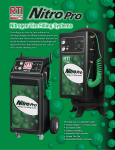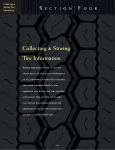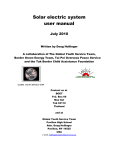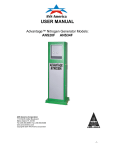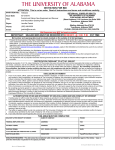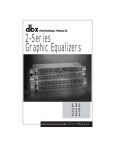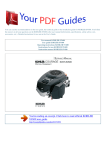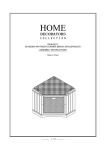Download Nitrogen Generator for Tire Inflation
Transcript
ua ir e Nitrogen Generator for Tire Inflation pn e Bulletin TSN2C Parker Hannifin Corporation Filtration and Separation Division 1-800-343-4048 10 Parker is the world’s leading diversified manufacturer of motion and ua ir e control technologies and systems serving many markets. Marine Mobile Machinery Hydraulic, fluid connector, seal, pneumatic, air conditioning and filtration components and systems. Hydraulic and fluid connector components and complete systems for mobile machinery. Food & Beverage Refrigeration & Air Conditioning Pneumatic, electromechanical and connector components plus filtration for automation systems. System-control and fluid-handling components and systems for refrigeration, air-conditioning and industrial equipment. Machine Tool Electronics Markets Parker serves: Commercial transport Military aircraft and missiles Regional transports General aviation Business aircraft Helicopters Engines Power plants/power generation Construction machinery Automotive Agriculture Transportation Mobile machinery Natural resources Machine tools Aerial lift Plastic machinery Mining equipment Hoists & cranes Lawn & garden Industrial machinery Conveyors Pulp & paper Metalworking Process control Printing Semiconductor manufacturing pn e Packaging Mobile air conditioning Mobile & industrial gerotors Industrial refrigeration Supermarket refrigeration Commercial refrigeration Residential air conditioning Fuel dispensing Chemical processing Rigid and flexible connectors and associated products for pneumatic and fluid systems. Hydraulic & pneumatic components and systems. Industrial and commercial sealing devices plus connector and related products. Aerospace Instrumentation Control systems and components for aerospace and related high-technology markets. Aviation fuel filtration products. High-quality critical flow components for process instrumentation, ultra-high-purity, medical and analytical applications. Telecommunications Information technology Marine Environmental Oil & gas exploration Process analytical applications Medical & bio/pharmaceutical Aerospace Automation Climate & Industrial Controls Filtration Fluid Connectors Hydraulics Instrumentation Seal Parker Tire$aver Nitrogen Generator ua ir e TM Why Use Nitrogen? Correct Inflation vs. Under Inflation Nitrogen is a dry, inert gas used to inflate airplane tires, off-road truck tires, military vehicle tires, and race car tires for improved performance. Oxygen in compressed air permeates through the wall of the tire, thus reducing the tire’s inflation pressure. During its journey through the tire wall, oxygen oxidizes the rubber compounds in the tire, causing under-inflation and deterioration of the rubber. Dry nitrogen will maintain proper inflation pressure and will prevent auto-ignition, will not corrode rims, and will help the tire to run cooler. The result is increased safety and reduced operating cost. Under Inflated Correctly Inflated Correct inflation is highly significant when considering tire life and performance. It is not always possible to look at a tire and detect under-inflation. However, under-inflation can cause many tire related problems. As inflation pressure largely determines a tire’s load capacity, under-inflation results in an overloaded tire. An underinflated tire operates at high deflection resulting in decreased fuel economy, sluggish handling and may result in excessive mechanical flexing and heat build up leading to catastrophic tire failure. Improved Tire Life Experts in the tire industry indicate that oxidative aging is one of the primary causes of limited tire life. Oxidative aging is caused by the diffusion of air from the pressurized pn e Nitrogen will help to extend tire life by reducing premature failure of the tire. The causes of premature tire failure which are affected by nitrogen include: ◆ Rubber deterioration by oxidation ◆ Rim corrosion ◆ Under-inflation ◆ Overheating ◆ Pressure increase due to heat build up ◆ Uneven wear due to improper inflation Parker Hannifin Corporation Filtration and Separation Division 1-800-343-4048 air cavity of the tire to the outside atmosphere. Tests have shown that if tires are inflated with nitrogen, there is a significant reduction in tire failure. Oxygen diffuses through the tire much faster than nitrogen Oxygen Nitrogen Cross section view of a tire 1 ua ir e Reduced Operating Cost Tires are one of the primary costs of operating a fleet of vehicles. Tire costs include procurement, maintenance and the cost of blowouts. A typical truck tire with two retreads costs $480.00 and lasts approximately 270,000 miles. Inflating tires with nitrogen will help to prevent premature casing failure and allow tires to be retread multiple times, with confidence and reliability. Inflating tires with nitrogen to eliminate oxidative aging might extend tire life by up to 25%. Increasing tire life to 337,500 miles would save $120 per tire. A fleet with 50 trucks and 900 wheel positions would save over $100,000 in tire cost by inflating with nitrogen. The primary cost of maintaining tires is the cost of labor to check tire pressures and top off tires with compressed air on a periodic basis. Tire pressure must be checked and the tires topped off due to the diffusion of air through the tire. Tires filled with nitrogen will not experience this diffusion and resulting loss of pressure. Tires filled with nitrogen maintain pressure for a much longer period of time than tires filled with air. If a truck fleet conducts preventative maintenance on 5 trucks per day and presently spends 30 minutes per truck topping off tires, they could realize savings of $31,250 per year based on a labor rate of $50 per hour and 250 work days per year, by inflating tires with nitrogen. Tires are one of the highest operating costs for fleets. Reaction from Fleet Owners: The cost of a service call to repair a blowout can be $500 or more. Consider the hidden costs of a blowout: ◆ Penalties for delayed product delivery ◆ Spoilage of product ◆ Driver idle time Cost of lost production or lost revenue from having the truck out of service Extra travel time for a mechanic ◆ Extra repair time due to field conditions ◆ Damage of associated parts ◆ Refunds of shipping costs pn e ◆ ◆ ◆ Loss of goodwill ◆ Overhead costs “I don’t have to waste time during routine maintenance topping off tires, just a quick check does it. It’s a real timesaver.” - Long Haul Fleet Owner “Nitrogen eliminated an uneven wear problem we had with our vehicles.” - Chief of Police “As a result of filling tires with nitrogen, we save about one half hour per PM for each truck.” - Long Haul Fleet Owner Enhanced Safety for Vehicles The most significant benefit of filling tires with nitrogen on automobiles is enhanced safety. Underinflation of tires due to the diffusion of air through the tire was identified as a significant cause of recent tire failures. In fact, the TREAD Act recently passed by the US Congress requires the National Highway and Transportation Safety Agency (NHTSA) to develop an on board warning of low tire pressure in all automobiles. A recent article from the Wall Street Journal states: “One thing government and tire-industry officials agree on is the importance of keeping tires properly inflated. The risks of underinflation, which stresses tires by causing their sidewalls to flex more and the air temperature inside to rise, were highlighted during congressional hearings two years ago into the Firestone tire problems. Underinflation was identified as a factor in the failure of Firestone tires.” -- Wall Street Journal, September 25, 2002. Parker Hannifin Corporation Filtration and Separation Division 1-800-343-4048 2 The Parker Nitrogen Generator: Produces high purity nitrogen from compressed air Requires simple wall mount installation (floor standing model also available) Allows inflation of up to 32 truck tires per hour Requires no storage of nitrogen Operates in the low pressure range up to 150 psig Inflates tires at the same rate as compressed air ◆ Includes two stages of high efficiency prefiltration and oil removal filtration Extends tire life by up to 25% Improves fuel efficiency by up to 4% Provides more consistent tire pressure Prevents auto-ignition of tires Eliminates rim corrosion Results in tires operating at lower temperature ua ir e ◆ ◆ ◆ ◆ ◆ ◆ ◆ ◆ ◆ ◆ ◆ ◆ Features and Benefits: ◆ ◆ ◆ ◆ Auto shut down = less wear and tear on compressor, less energry use Complete prefiltration package offering maximum reliability and longest operating life Receiver tank included Broad operating temperature range. Nitrogen can be generated automatically, without electricity (and troublesome heaters), in a cold garage bay How does the TireSaver system work? gas at the point of use for a wide variety of applications including general manufacturing, food processing and packaging, chemical blanketing, and chemical analysis. This same technology is now available for inflating tires with nitrogen. pn e The benefits of inflating tires with nitrogen as opposed to compressed air have been well known to the tire and transportation industries for many years. In general, tires filled with nitrogen improve tire life, reduce operating costs and improve safety. Until recently, there has not been a convenient, reliable, economic means of providing nitrogen to inflate tires. In the past, nitrogen would be provided in large liquid tankers transferring the nitrogen to large storage vessels or as a gas in high pressure cylinders at 2500 psig. In recent years membrane technology has been developed to purify air into a stream of high purity nitrogen. This technology is being used to generate nitrogen Parker Hannifin Corporation Filtration and Separation Division 1-800-343-4048 Hollow fiber membrane technology is used to generate nitrogen on-site. 3 ◆ ◆ ◆ ◆ ◆ ◆ Compact wall mount system, frees up floor space No electricity, easy installation Membrane does not degrade over time providing consistent high performance throughout life of membrane No moving parts, reliable operation Simple anuual maintenance High capacity floor standing model is ideal for high volume dealerships The Parker Tire$aver Product Line Model TS02 (Wall Mount) ua ir e TM Models TS06, TS18, TS24 (Wall Mount) Model TS24F (Floor Standing) (Receiving Tank and Prefilters Not Shown but Included) What Industry Leaders Say: ◆ Goodyear says 15% under-inflation = 8% less tread mileage and 2.5% decrease in fuel economy. -- Goodyear Radial Truck Tire and Retread Service Manual, Pg. 40 ◆ United States Department of Energy says the United States loses over 2 million gallons of fuel each day due to under-inflation. ◆ TMC (Technology & Maintenance Council of American Trucking Association) says that about 90% of tire failures causing tire road debris is caused by underinflation. -- TMC Tire Air Pressure Study, May 2002 pn e ◆ Michelin Supports the use of nitrogen based on its ability to better retain pressure over a period of time. -- Michelin Technical Bulletin, November 2003 ◆ Pirelli says 20% under-inflation = 15% shorter tire life. Parker Hannifin Corporation Filtration and Separation Division 1-800-343-4048 ◆ Bridgestone says air inflated tires lost an average of 2.7 psi per month and nitrogen inflated tires lost an average of 0.7 psi per month. - Guy Walenga, Clemson Tire Conference, March, 2004 4 Principal Specifications Model Nitrogen Purity Nitrogen Capacity TS02 TS06 TS12 TS18 TS24F 95% 95% 95% 95% 95% 1.75 SCFM 6 SCFM 12 SCFM 17.5 SCFM 34 SCFM 150 psig 150 psig 150 psig 150 psig 150 psig Ambient temperature 68°F 68°F 68°F 68°F 68°F Tire Inflation Capacity 30 tires/hour (195/65R15 size) 7 tires/hour (11R22.5 size) 14 tires/hour (11R22.5 size) 24 tires/hour (11R22.5 size) 32 tires/hour (11R22.5 size) – 200 tires per hour – (195/65R15 size) – – -50°F -50°F -50°F -50°F -50°F 40°F - 110°F Temperature 40°F - 110°F 40°F - 110°F 40°F - 110°F 40°F - 110°F 100 - 150 psig 130 - 190 psig Pressure Required 130 - 190 psig 130 - 190 psig 130 - 190 psig Maximum Compressed 190 psig Air Pressure 190 psig 190 psig 190 psig Compressed Air 40°F - 110°F 40°F - 110°F Temperature Range 40°F - 110°F 40°F - 110°F 40°F - 110°F 5 SCFM Consumption 35 SCFM 50 SCFM 100 SCFM Nitrogen Dewpoint Ambient Operating Compressed Air Compressed Air Compressed Air Pre-filtration Activated Carbon Filter Generator Size 190 psig 18 SCFM Two Stages Coalescing to 0.01 micron ▼ Inlet pressure ua ir e Principal Specifications 32”hx19”wx5”d 33”hx22”wx6”d 33”hx22”wx6”d 33”hx22”wx6”d 69”hx24”wx20”d Pre-filtration Dimensions N/A 30”hx10”wx3.5”d 30”hx10”wx3.5”d 30”hx10”wx3.5”d NA Storage Tank Dimensions 40”h x 18”dia 40”h x 18”dia 40”h x 18”dia 40”h x 18”dia 40”h x 18”dia Generator Net Weight 66 lb. 77 lb. 77 lb. 88 lb. 210 lb. Total Shipping Weight 150 lb. 250 lb. 260 lb. 260 lb. 422 lb. Inlet/Outlet Connection 1/2” NPT/1/2” NPT 1/2” NPT/1/2” NPT 1/2” NPT/1/2” NPT 1/2” NPT/1/2” NPT 3/4” NPT/1/2” NPT Noise Level <45dBA <45dBA <45dBA <45dBA <45dBA Annual Filter Element Change Annual Filter Element Change Annual Filter Element Change Annual Filter Element Change Annual Filter Element Change – Annual Carbon Change Annual Carbon Change Annual Carbon Change Annual Carbon Change Auto Tires Truck Tires Truck Tires Truck Tires Truck Tires Nitrogen Generator TS02 TS06 TS12 TS18 TS24F Maintenance Kit* MK-L9000 MK-L9001 MK-L9001 MK-L9001 MK-L0991 pn e Required Maintenance Application Ordering Information *Maintenance Kit includes filter elements and carbon bed for annual change. Parker Hannifin Corporation Filtration and Separation Division 1-800-343-4048 5 pn e ua ir e Notes Parker Hannifin Corporation Filtration and Separation Division 1-800-343-4048 6 pn e ua ir e Notes Parker Hannifin Corporation Filtration and Separation Division 1-800-343-4048 7 pn e ua ir e Notes Parker Hannifin Corporation Filtration and Separation Division 1-800-343-4048 8 ua ir e Inflating Tires with Nitrogen Provides Wide Ranging Benefits: ✔ Commercial airlines have used nitrogen tire inflation for years for consistent inflation pressure and minimized oxidation of rubber compounds ✔ Race cars and motorcycles use nitrogen in tires for improved, consistent handling and reduced operating temperatures ✔ Off-road construction pn e vehicles use nitrogen tire inflation to achieve consistent tire pressure and to prevent auto ignition ✔ Truck fleets can use nitrogen tire inflation to improve fuel efficiency, extend tire life and reduce the frequency of blowouts ✔ Automobiles use nitrogen tire inflation to improve safety and extend tire life Parker Hannifin Corporation Filtration and Separation Division 1-800-343-4048 9 Parker’s Global Presence in Nitrogen Tire Filling: Parker Hannifin is the global leader in supply of nitrogen generator technology for inflation of tires. Parker’s success includes: ◆ 350 Automobile service garages in Germany ◆ Volvo Netherlands uses nitrogen for tire inflation ◆ The largest taxi company in the world uses the Parker Nitrogen Generator for tire inflation ◆ Leading garage equipment manufacturers worldwide use Parker membranes ◆ More than 4000 units in service worldwide ◆ Nitrogen and Parker nitrogen generators have been used successfully for years to inflate tires used on automobiles, trucks, race cars, military vehicles, airplanes and off road construction vehicles.











